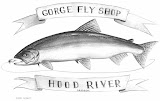Aug 9, 2012
Sage One 7136-4 Spey Review
I wanted to see if all the hype surrounding the Sage One Spey was true so I picked up a 7136-4 One Spey from the shop and headed down to the Hood for an afternoon of casting and well, I guess I fished a bit too. Nobody home on the fish front, but I did learn plenty about Sage’s latest contribution to the Spey world.
I brought a bunch of lines with me. No mid speys or long bellies – mainly just Skagit and Scandi lines and a few shorter lines of the switch variety. I started out by lining up an Airflo 510 Skagit Compact with a 10 foot T-14 Sink Tip (Rio MOW Heavy), which felt just about perfect. Then I tried the 540 Airflo Compact which was too heavy for my liking. Then I moved over to the Scandi Lines… I tried a 480 Rio Steelhead Scandi as well as the Airflo 480 Scandi Compact. I like both lines equally well, however, they both felt too heavy for the 7136-4. As I have voiced in the past, I think one of the many benefits of the Scandi over the Skagit is the ability to lighten up and feel more agile while casting. To me these two 480 grain lines were very noticeably heavy.
On day two, I brought a few more lines with me, as well as my older 7136-4 Z-Axis to try out for a side by side comparison. First, I lined up the One Spey with a 525 Rio Skagit Flight. Overall, this felt like a great fit, but on the heavier end of my range. Rio actually recommends the 525 for this rod, which is interesting because their advice on lining rods is typically pretty light. But their line charts for these rods seem to be average – heavy. I think most people who have grown used to casting the Flight will like the way the 525 performs but for those who are looking for linespeed, the 500 grain Flight felt like another fine option. This is about as light as I would go, however.
Then I tried the 510 Airflo Skagit Switch on this rod, and guess what… It’s like a cannon! It’s a few feet shorter than the standard Skagit lines so you need one more line strip before the cast, but if you can put up with that, I think this line is a winner! Short Skagit heads like the Switch load your rod up so effortlessly while fishing in tight quarters. You just need to leave a bit more overhang out the rod tip on a 13 ½ foot rod so as not to pull your anchor.
Onto the Scandi lines… I tried a 450 Rio Steelhead Scandi and a 450 Airflo Scandi Compact. This was the ticket. I found them to be plenty heavy to load up the rod with a nice relaxed stroke. Then, by adding some power to the stroke, the line really started to take off.
On an earlier post, I wrote about the Rio Scandi Short Versitip. I love it. Rio recommends lining the 7136-4 with the # 8 SSV but this is too heavy. I like the #7 SSV on this rod. In fact, it casts extremely well with this combination. I know that it is only 425 grains. But believe me, this is the one you want for this rod. Check out the Post on the SSV for a more detailed review on this line.
So after casting all these lines on the One, I lined up the 510 Airflo Skagit on both the Sage One 7136-4 and the Sage Z-Axis 7136-4 for a side by side comparison. Now, up until this point my feelings about the One were that yeah, this is a really nice rod. But it wasn’t until I switched back in forth between the two that the real difference in quality surfaced. Immediately, the Z-Axis (the rod that I have fished for years) felt like a heavy, old clunker in hand. The tip felt really gummy on the cast and the overall feel of the rod seemed incredibly sluggish after casting the One Spey. It was like the entire cast became more labor intensive and overall, less efficient! I could still send out nice looking loops of line, but everything seemed to lack sensitivity and urgency…
Switching back to the One was like night and day. It’s got way more zip and it is much lighter. Furthermore, the flex pattern on this rod is more progressive than the Z-Axis. The top third is much stiffer but, albeit, sensitive and extremely responsive. I wouldn’t call it stiff though. It is not nearly as stiff as the Sage TCX Spey Rods, per say. However, the One has no problems generating the line speed that is seen with the TCX.
It’s comfortable yet powerful. And it’s so sensitive. This rod is different. I’d have to say the hype is totally justified – which really makes me wish that I could afford one right now. To sum it up in a sentence… I think that Sage has created a rod that has a very easy time operating at the top of the performance spectrum. What they’re all saying is true. Hit Sage One 7136-4 Spey for additional specs.
Have a good time!
Subscribe to:
Post Comments
(
Atom
)


























No comments :
Post a Comment